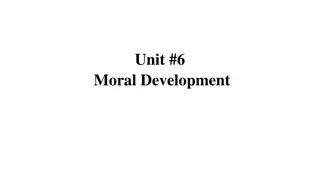Leadership and Moral Norm Change: Beyond Rational Persuasion
This study explores how formal leaders can change moral norms through morally risky actions, with the participation of followers. It delves into the theory of moral entrepreneurship, practice-based leadership, and institutionalism to understand how leaders embedded in practices bring about radical norm changes. The process involves identifying anomalies in prevailing norms, proposing and executing groundbreaking actions, and ultimately establishing a new normative order.
Download Presentation

Please find below an Image/Link to download the presentation.
The content on the website is provided AS IS for your information and personal use only. It may not be sold, licensed, or shared on other websites without obtaining consent from the author.If you encounter any issues during the download, it is possible that the publisher has removed the file from their server.
You are allowed to download the files provided on this website for personal or commercial use, subject to the condition that they are used lawfully. All files are the property of their respective owners.
The content on the website is provided AS IS for your information and personal use only. It may not be sold, licensed, or shared on other websites without obtaining consent from the author.
E N D
Presentation Transcript
Beyond Rational Persuasion: How Leaders Change Moral Norms Charles Spinosa Matthew Hancocks Haridimos Tsoukas Billy Glennon
Core argument Formal leaders, in the face of moral anomalies that defy current moral reasoning, change norms by undertaking morally risky rule-breaking actions with the complicity of followers.
Literature review and research question Moral entrepreneurship theory Practice-based leadership Institutionalism How do leaders, embedded in practices, bring about radical change in norms among followers through undertaking morally risky actions?
How leaders change norms radically: A theoretical account Normative order: Grounding practices Organizing practices Clarifying practices
How normative orders change radically 1. There is a prevailing normative order where people have a clear sense of what is right to do 2. A leader is captivated by and calls attention to an anomaly within the prevailing normative order 3. The leader takes a mild moral risk in proposing actions to resolve the anomaly in a way that goes against the prevailing normative order 4. The leader takes, and succeeds at, a shocking action in response to the anomaly, but the implicit norm change is only faintly understood 5. The leader takes, and succeeds at, another shocking moral risk, which is understood; the new normative order arises Illustration: Churchill changes the British normative order in 1940























